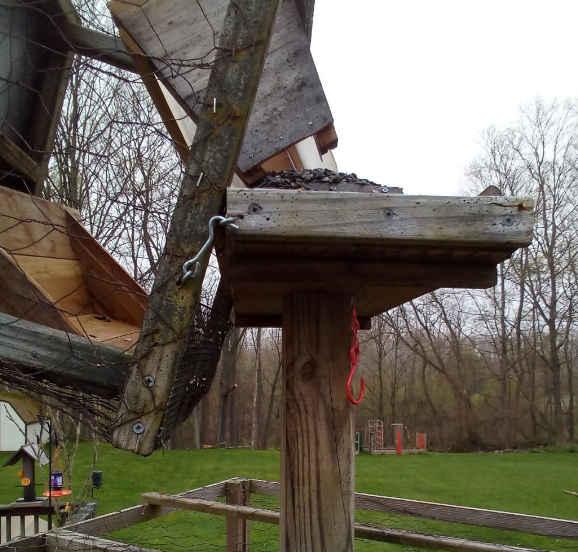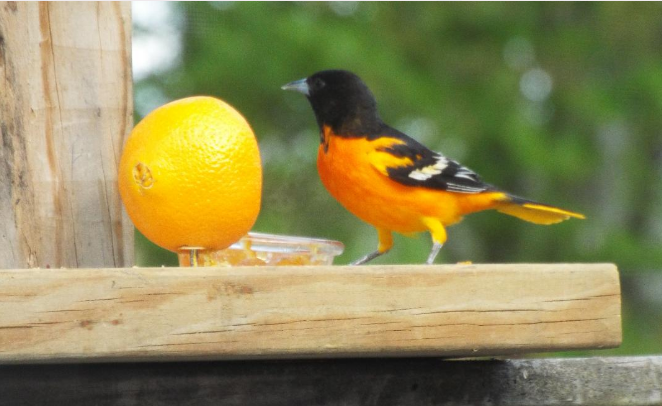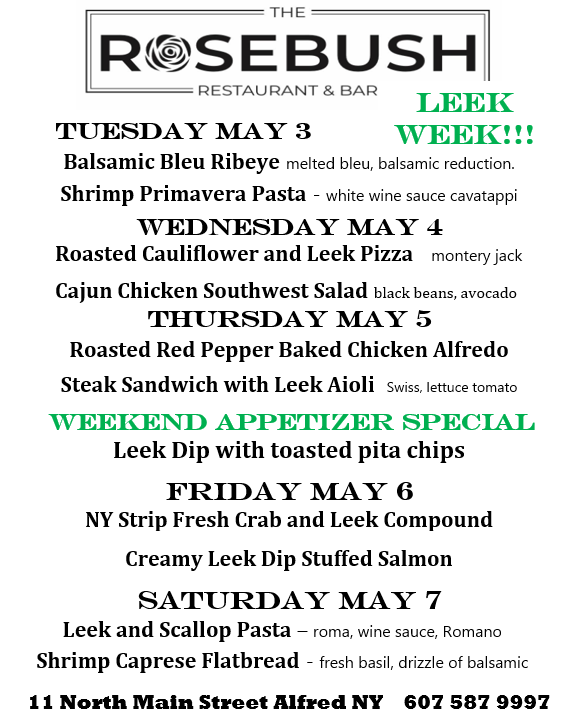By Chuck Wiser, I write the words to share what my eyes see and my heart feels
Given our passion for, and addiction to, sightings and the observation of area birds year round, we keep a pretty close lookout, especially in the Spring. As with my words, nothing pleases me more than being able to share what we see, with others. I am somewhat known for the many pictures I share to Social Media. I am not a dedicated “birder” having a vast knowledge of all things aviary so most of what I write about herein will be anecdotal from personal experience with some reference to such sources as Wikipedia, Google and the Audubon Society. Any errors or misrepresentations are my fault, and not caused by my sources.
When I was still a preteen living next to what is now known as Rte. 375 between Nile and Richburg, I considered the Red Wing Blackbirds as my friends as they would sing to me or at least chirp at me, as I walked, or more often ran, to our house after visiting friends in the heart of the “city” of Nile. For the longest time these were my favorite of all birds. Shortly after moving to our current Scio, NY address along the Back River Road, we discovered the beauty of the Cardinals, which are more formally known as Northern Cardinals, predominantly seen in the Eastern half of the US. We immediately fell in love with them and upon a little research as to what food would attract them, we started putting a feeder out supplying them with the most common of their human source of foods, the Black Oil Sunflower seeds.
The name Cardinal derives from the red color of the males matching that of the robes of the Roman Catholic Bishops. Cardinals are members of a family of songbirds that include; Grosbeaks, Buntings, and Tanagers, among others. The Cardinals red color derives from a food compound in their natural diet called Carotenoids. This is similar to a compound named Melanin which gives humans their color.
The Cardinals habitat, geography and popularity is so broad that it is the National Bird of seven states, which does not include New York State. The American Robin was our state bird until 1970 despite a late 1920’s push by the New York Federated Women’s Club to change it to the Eastern Bluebird, presumed to be more popular.
The Cardinals, which typically mate for life, will, as do most birds, build a new nest every year and may have one to two broods each year. Given their year-round availability, not being migratory, I guess I would say that they are our favorite bird. That is not to say however, that we might tend to ignore them when a fresh batch of a few others join us during the Spring of the year. The visits of these migratory visitors have inspired me to explore and share a little more information on the spate of the old friends that have once again joined us.
Somewhere along in through the early 90’s I was out and about probably chipping golf balls in the field adjacent to our house, when I heard a melodious song being “warbled” by a nearby bird. I looked and looked and finally discovered a bright orange and black bird high atop a tree on the bank of the ditch formed by the old Buffalo and Susquehanna Railway Company rail bed that parallels the Genesee River behind our house. I raced inside to tell my wife about it and we looked it up in a birding book gifted to us by a family member years previously. It was indeed a male Baltimore Oriole. I would see and hear that, or others, throughout that year and a couple more to come. One year, on an early early Spring day, one of those birds landed on our Hummingbird feeder trying to feed on the nectar. I believe that happened maybe once or twice that year and then again, the next year prompting us to investigate trying to attract those colorful and melodious birds. Over the past several years our feeding stations have evolved as we learned what the Orioles in general like, and what attracts and keeps them coming back every year. We now provide a menu of choices and offerings including cut Oranges, Grape and Marmalade Jelly, and Flavored Nectar. The eating habits of the birds vary and over the years we have some that choose one or more of the offerings and even some that will feed on the Peanut Pellets or Suet Cakes we provide for the Woodpeckers. We have found that, of the “jellies”, grape is preferred by all when they first arrive in the spring but later in summer when they are feeding their young, they prefer the Orange Marmalade as it seems easier to carry back to the nest to feed their young. When trees are budded early the Orioles may eat the tender buds and insects in the trees. As an aside, the nests are like an upside down, hanging, loosely knitted sock.
The next migratory feathered friends we adopted were the Red Breasted Grosbeaks. Actually, they were not the first type of Grosbeaks we would encounter. Prior to our seeing or recognizing any of those we were visited in late fall by a small flock of birds that we discovered to be Evening Grosbeaks. Their coloring pattern was like a Grosbeak, but more closely resembled a wintertime male Goldfinch. As it turns out these Grosbeaks are typically not “Migratory”, in that they don’t leave to head for Mexico or South America as the typical annual migratory species do. They seem to stay around all year and will move around depending on finding a sufficient supply of their food source. We may see them for a few days in the late fall or late winter, early spring, but then they move on.
I think our housing location choice in the early 70’s was fortuitous in that we are close to the Genesee River on the West side with a wooded area between, which seems to be a haven for nested, mated pairs, of birds.
The Rose Breasted Grosbeaks are tied with the Orioles, but a close second to the Cardinals, as our favorites. These two species generally arrive within a week of each other, and the males precede the females by a few days to scout and select a nesting site and start making their summer home. The Grosbeaks nest is readily identifiable but normally not visible to we mere mortal homosapiens until after the leaves have departed from the trees, well after their southward migration has transpired. These birds make a new nest every year as do the cardinals.
Unlike the Cardinals, the Orioles and Grosbeaks do not mate for life. They are monogamous in that they remain with the same mate through the brooding season but will find a new mate for the next season. The Grosbeaks, unlike the Orioles which avoid them, will join the other permanent residents in feasting on Sunflower seeds although they do eat bugs and insects and some tender leaf buds.
The Rose Breasted Grosbeaks are the first to arrive in the Spring, usually at the end of April or first week in May. The Orioles are close behind them by a few days. Most migratory birds tend to travel at night. This would seem odd thinking they need to see where they are going but they really don’t fly by sight as much as by their memory, instincts and their built in migratory map. There are three general reasons why they do travel at night. Most obvious is safety from predators such as Hawks and other “foul” species that rely on vision of their prey.
Secondly, the energy required in flying, generates substantial body temperature increases and the cooler evening air helps to cool them. Thirdly, night-time air is typically more calm and less windy making flying less arduous. Hummingbirds sometimes travel at night but more typically they will rest in the cavity of a tree that is sheltered and warmer overnight. Lore has it that Hummingbirds hitch a ride on the backs of the migrating geese. Look it up. I didn’t. I like that story too much to be disillusioned by whatever the reality may be.
The speed of flying birds closely approximates that of our, or some of us, driving a car. Their speed can vary from 15 to 55 miles per hour. Traveling predominantly at night they can cover 15 to 600 miles in a single trip. Equating that to a distance, at the upper end of that speed range it would only take one night to fly across the width of Montana.
The Buntings are typically the last to arrive and aren’t as plentiful as the other bird species. Some years they share with us the beauty of their faux color for just one day in passing, stopping by to check out what gourmet bird treats we have. Other years we have had one to three of them spend the entire summer. Unlike most of our other aviary friends their menu does not typically include sunflower seeds. They prefer the smaller domestic bird seed. Although the splendor of their beauty is what ingratiates them to us it isn’t really what you see, that is. They are not that “indigo blue” in color, they are actually black in color but the iridescence of their coloring makes them look blue.
It is no mystery why the above-mentioned feathered friends are called songbirds. Once you learn their sound you can pick them out of a crowd. The Cardinal is multi voiced having a call during mating season quite different than their normal distinctive sing song sound. The Grosbeak I relate to the sound of a Robin but albeit a little higher pitched and more melodious. The only way that I can describe the Orioles singing is to call it a “warbling”. There is no mistaking the “scolding chatter” that comes from the Orioles however, and it is often used when they arrive at the feeders early in the morning before we have had a chance to put the feeders out. We must bring the feeders in at night as our resident critters like the racoons also like the foods, including sunflower seeds, that their smaller animal kingdom welcome friends like.

Over the years our providing a “supplemental” diet of sunflower seeds to any number of birds desirable to us, has created a dislike of the unwanted “predator” birds and animals which mainly due to their aggressive, disruptive or gluttonous behavior are not welcome at our feeding stations. These include Squirrels, such as the; Black, Grey, Red, and the Woodchuck sized Fox Squirrels; Chipmunks, Blue Jays, Cow Birds which are unscare-able and any kind of Black bird including Starlings, Crows and Ravens, Bears and Raccoon. Here is why we call them predators. This picture from last night shows why. Forgot to put the cameras out last night so not sure what caused the above damage. If you find a red rooster shaped suet feeder it’s ours.

The Birds of Spring
The rains in April to us bring’, Flowers that bloom the gift of Spring.
While flowers brighten days in May, they sign to us what’s on its way.
First come the Grosbeaks, with us stay, their songs bring music to our day
Then Orioles their colors bright, to chase the darkness of the night
The Hummingbirds will soon arrive, the Winters gloom from us to drive
And finally, the buntings’ here, not seen often but to us dear
The birds that left us in the fall, bring joy to Spring that brightens all
Soon thereafter broods will hatch, their colors bright, watch them match
The birds of Spring will show us love, sent round to us from up above
These gifts to us may banish strife, and bring to us a joy, new life








